
Hastings Mill
Encyclopedia


Sawmill
A sawmill is a facility where logs are cut into boards.-Sawmill process:A sawmill's basic operation is much like those of hundreds of years ago; a log enters on one end and dimensional lumber exits on the other end....
on the south shore of Burrard Inlet
Burrard Inlet
Burrard Inlet is a relatively shallow-sided coastal fjord in southwestern British Columbia, Canada. Formed during the last Ice Age, it separates the City of Vancouver and the rest of the low-lying Burrard Peninsula from the slopes of the North Shore Mountains, home to the communities of West...
and was the first commercial operation around which the settlement that would become Vancouver
Vancouver
Vancouver is a coastal seaport city on the mainland of British Columbia, Canada. It is the hub of Greater Vancouver, which, with over 2.3 million residents, is the third most populous metropolitan area in the country,...
developed in British Columbia
British Columbia
British Columbia is the westernmost of Canada's provinces and is known for its natural beauty, as reflected in its Latin motto, Splendor sine occasu . Its name was chosen by Queen Victoria in 1858...
, Canada
Canada
Canada is a North American country consisting of ten provinces and three territories. Located in the northern part of the continent, it extends from the Atlantic Ocean in the east to the Pacific Ocean in the west, and northward into the Arctic Ocean...
.
In 1867, Captain Edward Stamp
Edward Stamp
Edward Stamp was an English mariner and entrepreneur who contributed to the early economic development of British Columbia and Vancouver Island...
began producing lumber in Stamp's Mill at the foot of what is now Dunlevy Avenue after a planned site at Brockton Point
Brockton Point
Brockton Point is located in Vancouver harbour at the east end of Stanley Park. It is named after Francis Brockton. Brockton Point Lighthouse, an automated light, is located at the point....
proved unsuitable due to difficult currents and a shoal. Stamp's efforts in developing the mill are summarized by Robert Macdonald in Making Vancouver: Class, Status and Social Boundaries, 1863-1913:
In 1865 he formed a company in England, backed by capital of $100,000 , to produce lumber in British Columbia. Stamp also secured from the colonial government of British Columbia the right to purchase or lease 16000 acres (64.7 km²) of timber on the lower coast, and selected a mill site on a point of land along Burrard Inlet's south shore. Delayed by the failure of crucial machinery parts to arrive from England, Stamp did not begin cutting lumber for export until June 1867. After managing the firm for less than two years he retired, and shortly thereafter his company went into liquidation in England. The mill closed for a period in 1870 but opened again in August after being purchased by Dickson, DeWolf and Company of San Francisco. Known at first as Stamp's Mill, it now became the Hastings Sawmill Company, or Hastings Mill.
The early settlement was in effect a company town. People shopped at the Hastings Mill Store and sent their children to the Hastings Mill School, which included students from Moodyville on the opposite side of the inlet. This would change after the CPR
Canadian Pacific Railway
The Canadian Pacific Railway , formerly also known as CP Rail between 1968 and 1996, is a historic Canadian Class I railway founded in 1881 and now operated by Canadian Pacific Railway Limited, which began operations as legal owner in a corporate restructuring in 2001...
chose Vancouver as the terminus for the transcontinental railway. Nevertheless, the lumber industry remained the backbone of the new settlement's economy, and Hastings Mill was "the nucleus around which the city of Vancouver grew up in the 1880s" and remained important to the local economy until it closed in the 1920s.
When Hastings Mill closed, the building that housed the Hastings Mill Store was transported by barge to the foot of Alma Street to begin a new life as the Old Hastings Mill Store Museum. Operated by the Native Daughters of British Columbia, the museum features Native American, pioneer and immigrant artifacts.
This was also one of the only structures to survive the great fire in 1886
Great Vancouver Fire
The Great Vancouver Fire was a conflagration that destroyed most of the newly incorporated city of Vancouver, British Columbia, Canada on 13 June 1886. The fire began as a brush fire to clear land between present-day Main and Cambie Streets that was spread out of control by a strong gale...
and was used as a hospital and morgue for the fire's victims.

